Collectors Corner: Interview with Kurt Kuersteiner
By Jeffrey Copeland © 2022 The Wrapper Magazine (#340)
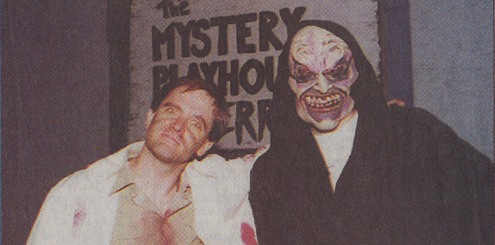
Kurt Kuersteiner is an eclectic expert, especially as that relates to his work in the world of nonsport cards. He is everything from passionate collector to highly knowledgeable card historian to creator of some of the most beautiful (and scary!) nonsport card sets of modern times. His contributions to our hobby have been tremendous, and if there were a “Nonsport Card Hall of Fame,” he’d surely be one of the inaugural inductees. So, sit back, relax, and enjoy this visit with one of the true icons of our hobby.
Jeff Copeland (JC): Please share with us the roots of Monsterwax. Why did you originally decide to get into producing the cards and sets?
Kurt Kuersteiner (KK): I disavow all responsibility for creating Monsterwax. The person who deserves that blame is your editor, Les Davis. I never told him this because I didn’t want him to feel too guilty, but if I had not encountered his magazine around 1990, I never would have become such an avid card collector, and then dealer and card producer in order to support my habit!
Nonsports cards were really on fire in the early 1990s, and I had stumbled across a copy of Chris Benjamin’s Sports Americana Price Guide in a Sarasota bookstore. I relished going through that book and seeing all sorts of sets I wanted—but I couldn’t find or buy them anywhere. (The Internet was just starting, and eBay didn’t even exist yet.) Then I noticed a small ad on page 569 for The Wrapper, and that’s when the floodgates poured open. I was in film school at the Asolo Motion Picture Conservatory at the time, and I quickly realized that if I wanted to spend money on cards, I was going to have to earn it while also taking a full load of classes. I needed something with flexible hours that could move with me after I graduated. Thanks to The Wrapper, I thought if I made my own cards, I could sell them in the magazine via mail order wherever I went.
I went over to the Ringling College of Art & Design, also located in Sarasota, and recruited half a dozen artists, and dove into the card biz without knowing very much. I just knew what I liked.
We produced a duotone factory set on old radio horror and sci-fi shows called Tune in For Terror. Harvey Elander saw it in The Wrapper and called me up. He wanted me to make a boxed series of wax packs in full color. He was very knowledgeable and provided me the confidence and encouragement I needed to take it further. He was a great mentor and made it all possible, so he shares the blame in bringing Monsterwax to life.

A Ricardo Garijo painting for War of the Worlds.
JC: To me, the artwork in the majority of your sets harkens back to the design and layout of such classic sets as Topps Space, Mars Attacks, and Horrors of War. They have the feel of the cards from the Golden Age of nonsport cards during the 1940’s through mid-60’s. Was this by design—or was it a function of the skills and interests of the artists you have worked with?
KK: Yes, to all of your questions. It was a function of the artists because that’s what attracted me to their work in the first place. I saw they had a similar style to the classic cards I liked—although no one could match the actual skill of Norm Saunders (Mars Attacks) or the great artists behind Horrors of War. Unfortunately, Topps eventually scaled way back on original art series because they didn't want to invest the time and money in commissioning good artists to do it or spend the time to write it. Why pay artists to paint another Dinosaurs Attack type set, when you had to “dump” much of that series the last time you tried it? Sure, companies would publish recycled art from great artists for card series like Hildebrandt or Franzetta, but we had a long, dry spell for original art cards until Skybox released Marvel Masterpieces the same year we did Tune in For Terror (in 1992).
JC: Related to that question, could you briefly describe your interaction with the artists who come up with the illustrations? Do you give them something like a “storyboard” to follow—or do you give a general idea of what you want and turn them loose?
KK: I use story boards because that’s what we were trained to use in film school, and it’s the best way I know to organize any series on paper. I’m a borderline artist myself—aware of how inferior I am to real artists, but good enough to do decent storyboards. It’s always a collaborative effort, so I tell the artists they have the freedom to change and improve things, which they often do with dramatic results. In those rare instances when their changes are too much or need to be altered, it’s only because they contradict some aspect of the story.
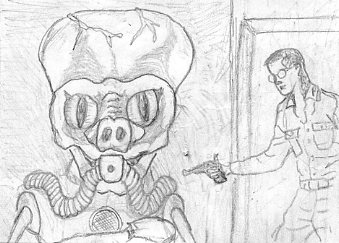
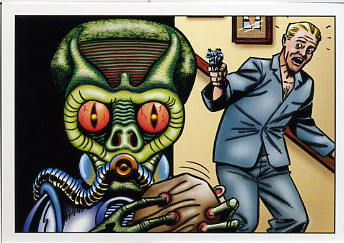
A sample storyboard image, and then the artist's version (by Terry Betty).
I love story cards, by the way. That’s another facet of traditional trading cards that has become rather scarce. Original stories, AND original art. After all, if you write an original story, you’re going to require original art (unless you photograph it with actors or models). Whether an episodic story like the Norm Saunders Batman series was or a continuous story like Mars Attacks, they are a very rare bird these days. But many of the best series of the past used that format, and I wish more did today.
JC: You cover an incredible range of subjects in your sets—everything from Monsters from Hell to 60’s Sci-Fi Terror to War of the Worlds to Urban Legends. How do you set the boundaries for what you do? What MUST the subject have before it can become a Monsterwax project and set?
KK: I grew up as a monster kid from the 1960s, and my favorite holiday was always Halloween. I loved anything monster, be it Aurora models, monster magazines, monster movies, or monster trading cards. In October, we would tape big refrigerator boxes to one another down in our basement to make tunnels, and create scary scenes in them to form a makeshift haunted house for our friends to crawl through. You could say I never grew up and I’m still doing now what I loved then.
So Monsterwax cards are typically topics that I cherished back then and still collect now: horror, monsters, science fiction, Halloween—plus prehistoric monsters (dinosaurs). We’ve tossed in a few historical topics like Don’t Let It Happen Here and War News Pictures, but those are both war related, and you could say that’s the ultimate horror topic.
If I think of a series that I really want but it doesn’t exist yet, I’ll try to make it myself. At least that way, if it loses money, I still have a series for my personal collection that I’m glad to own. (It just cost thousands more than I intended.)
JC: What have been your favorite sets so far, and why so?
KK: That’s a bit of a Sophie’s Choice! They are like children to me with different aspects that I adore. I love the vintage art style of Ricardo Garijo’s Don't Let It Happen Here, and the jingoistic text of the 1930s version that was mimicked for our version of it. I especially admire the writing of the Lovecraft series, but that's because it’s Lovecraft’s actual narration, and his prose is amazing. The same goes for the Time Machine, Dr. Moreau, and The War of the Worlds series. Wells was such an incredible Sci-fi visionary. Terry Beatty’s art on Urban Legends/ Shock Stories is a favorite, and writing those stories was a decades long challenge but very satisfying. I felt like they are 100 short stories, most of which would make delightful short films. I’m also a big Kolchak fan, so I really enjoy how the Night Slasher series turned out. The same goes for the Lost in Space series, which has phenomenal artwork—as does the Monsters From Hell. But if I were to guess our most popular series, it would probably be either Dinosaur Galaxy or Spook Show. We put everything into both of those series, and it shows. They are like well-researched books—fun to read, but broken up into bite-sized cards with fabulous artwork. Plus, I can think of no other card series that came with an actual Zombie Slave, like Spook Show 2 does!
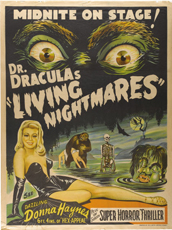 -
- 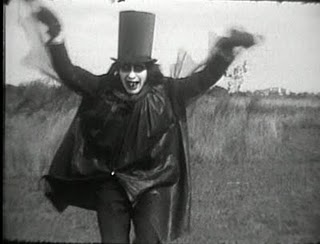
The Spook Shows were famous for their gorgeous (often garish) posters and over-the-top performers.
JC: Looking at the list of the sets you’ve produced, I’m guessing you very much enjoyed both monster and sci-fi movies when you were growing up. Which movies were your favorites?
KK: I was a big fan of all the Ray Harryhausen films. I still am. I thought the only thing better than a monster movie was a sci-fi movie with a monster in it. There are so many that I admire, but my all-time favorite is Curse of the Demon. It was directed by Jacques Tourneur (a Val Lewton favorite). It’s filled with atmosphere and suspense, and has a murderous but sympathetic villain. It also has an incredible monster, especially by 1957 standards!
JC: What are the biggest challenges of putting a set together.
KK: The biggest challenge for me is getting the time required to work on it properly. When I was single, I had plenty of free time. But now with a wife and two kids, looking for spare time to devote to a project is pretty daunting. I often do the writing when traveling to Taiwan to visit my wife's family. That's a 22 to 28-hour flight, depending on layovers. So, I get a chance to really deep dive into the plot and juggle the various storylines altogether in one sitting. (I try to devise the overall story arch before breaking it up into single cards.) Then, after we've landed, I'm more or less isolated from distractions because my conversational Chinese is poor, and their English is equally bad. So, I usually get between 2 - 4 weeks to focus on whatever the project is. I draw the storyboards on a stack of index cards (which I shrink down to fit into 9 pocket sleeves later on). I carry those index cards in my backpack and draw them wherever I am, be it a train, plane, or automobile. I'm always carrying a backpack, so if I get any down time, I can work on things.
JC: What do you hope people will say when they look at your sets? What reaction pleases you the most?
KK: I'm thrilled when they take the time to read the backs. Few people do! I know major card collectors who NEVER read the backs. I get it—because most the backs are written for kids and are a waste of time. But just because MOST companies are slap dash with their writing doesn't mean ALL of them are. People should at least read a few to make sure they’re not missing out on something good. To me, the backs are as important as the fronts, and I invest significant time on them. A good story is the backbone to any good series. All my favorite vintage card sets had quality writing on the back: Horrors of War, Jets-Rockets-Spacemen, Fight the Red Menace, Mars Attacks, Outer Limits, Terror Tales.... Some sets even had simplistic comic book style art, which I still loved because of the writing, like G-Men & Heroes of the Law and Strange True Stories. One of the crudest card sets ever is still a personal favorite because of its wonderful backs: the original Don't Let It Happen Over Here. I hope if I collect and appreciate good cards that are older than I am, then maybe other collectors will do the same with my cards after I’m gone.
JC: That brings me to your other writing, your books like The Old-Time Radio History of Horror, The Art of Jack T. Chick, and 113 Tales of Terror. What is your next book project?
KK: You can tell from my titles I tend to write about rather esoteric topics! But they're topics I love and find fascinating, and I try to make them both interesting and entertaining. My next book is the most niche topic yet, but one that Wrapper readers should find interesting since it's about trading cards. It's called The Mega Monster Card Catalog—a giant catalog of every known monster set I've dug up from now, all the way back to the birth of Christ! Luckily, the first 1,958 years had no monster sets at all, so that made it a lot easier for me. But that still leaves a lot of fun (but unknown) cards that are from independent or offbeat card companies, as well as countless cool sets from overseas. It's well over 500 different series, and a lot of them are a real hoot! I've been working on this for years, and I’ve collected sets or samples of nearly all of them, so it almost feels like a swan song to finally publish it. It features full color samples of a front and back from each set, as well as commentary, so I think monster card collectors will really enjoy it. It’s coming sometime early 2022.
JC: Ok – I’ve just got to ask you something I’m sure Wrapper readers will enjoy hearing about. I’ve heard you run a Haunted House every year close to Halloween. Please tell us how it came about and why you do it.

The Monsterwax warehouse also serves as a "scarehouse" every Halloween (since 1999).
KK: It’s a childhood habit. We loved making those haunted houses in our basement, so it was only natural I would try it again. The inspiration occurred when I moved North to Pennsylvania after finishing film school in South Florida. I was hired to work at an ABC TV station in Harrisburg. There were two things that were very alien to a Southerner like me. One was all the snow and ice in the winters, and the other was all the haunted houses they offered in the fall! I don't mean little home haunts like what we had in Florida, but full-scale commercial operations with a big staff, large layouts, and a dedicated audience! They had lots of different haunts too, and several farms had them right outside the city. I loved how they took my childhood obsession and turned it into a giant spectacle. Then I realized they could still be better if they incorporated some of the special effects, illusions, and stagecraft I had studied for film production. When I returned to Tallahassee, I wanted to try my hand at it. Eventually, I rented an abandoned restaurant in 1999 and managed to pull it off. It was LOT more work than I imagined. On the other hand, it was a lot more fun than I predicted, so I kept at it, and it grew and grew. During the next two decades, we moved to three different locations, always improving, and now it's a giant operation with detailed sets, really cool illusions, and tremendous scares. In fact, we have customers wet themselves on a regular basis, and others bail out early every night, unable to take it. It's very satisfying.
JC: This year is the 30th anniversary of Monsterwax. First of all, congratulations! Please tell us what you see next for Monsterwax?
KK: Has it been that long? Gadzooks! But I don't have any grand strategy. I just take it one project at a time. I try to do each series like it's my last and best, and I don't save anything for next time because I never know if there will be a next time. If I don't think of another set that needs to be made, then I’ll retire.
JC: Is there anything else about cards you want to share with Wrapper readers?
KK: Only that I think Nonsports cards are an under-appreciated art form with a much greater potential than they currently fulfill. They are mostly used to promote other art forms, like licensed movies, tv shows, or comic books, etc. That makes them easy to produce and people buy them, so sure, why not? Just recycle an existing piece of art or a publicity photo (or film grab) for the front, then slap a puzzle image or some simple text on the back and Bob's your uncle. It's a formula and it works. But cards can be so much more than that. It doesn't have to be a cheap promotion for some other entertainment form. It could and should be its OWN entertainment art form, as it was with series like Battle, Civil War News, Mars Attacks, Dinosaurs Attacks, and Toxic High. I hope to see more original cards in the future, and with any luck, I hope to help create some of them.
JC: Kurt, thank you for sharing this fascinating information about yourself and Monsterwax. We wish you all the best as you continue forward with your projects!
All the above images are copyright © 2022 Monsterwax.com and cannot be used without written permission.